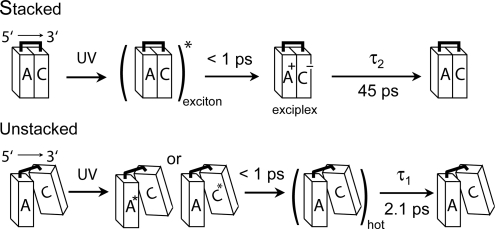Fig. 5.
Kinetic model for excited-state decay in DNA. Fundamentally different relaxation pathways are postulated for stacked and unstacked conformers as illustrated for the dinucleoside ApC. The bases in π-stacked structures are in van der Waals contact, and the resulting electronic coupling produces an exciton state upon UV excitation. This initial exciton decays on an ultrafast timescale to an exciplex or charge-separated state, which subsequently decays to the electronic ground state with a time constant τ2. When bases are poorly stacked, a local excited state is produced that decays on an ultrafast time scale to a hot ground state that thermalizes with time constant τ1.

